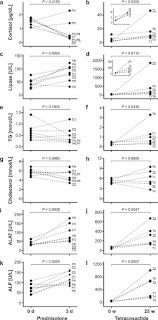Glucocorticoids (GCs) are important regulators of metabolic control in mammals and their aberrant function has been associated with several pathologies. GCs are widely used in human and veterinary clinical practice as a potent anti-inflammatory and G.Pig Serum Albumin immune suppressive agent. Dyslipidemia is a consequence that is often observed GC treatment, is characterized by increased lipolysis, lipid mobilization, liponeogenesis, and adipogenesis.
Dogs with excess GC events hyperlipidemia, hypertension, and higher risk of developing diabetes mellitus type 2, but lower the risk of developing atherosclerotic lesions compared to humans. This study aims to examine changes in the dog lipidome plasma in experimentally induced models of short-term and long-term GC excess. Both treatments led to significant changes in plasma lipidome, clearer after long-term exposure to steroid excess.
In particular, monohexosylceramides, phosphatidylinositols, phosphatidylcholines ether, acyl phosphatidylcholines, triglycerides and sphingosine 1-phosphate showed a significant change. Now the study highlights the hitherto unknown effect of GCS on lipid metabolism, which will be important in further explanation of the role and function of GCS as a drug and the metabolic and cardiovascular diseases.
In vitro assessment of the long-term stability of the inhibitory effect of plasma of dogs and cats on MMP 2 and 9.
To evaluate the effect of increasing the storage time on the inhibitory effect of plasma of dogs and cats in the matrix metalloproteinase (MMP) 2 and 9 in vitro.Matrix metalloproteinase 2 and 9 activity in the presence of a dog plasma stored for 57, 155, 222, 316, 367, and 438 days and plasma cats kept for 17, 198, 565, and 954 days was tested using a commercially available colorimetric assay kit.
For dog plasma, the activity of MMP 2 for the Goat Plasma older samples did not differ significantly from the 57- day samples (P = 0, 2025-.9033). Two samples of dogs has significantly lowered the activity of MMP-9 from the sample 57 days (367 days: P = 0.0099, 438 day: P = 0.0348, P = 0.0778 to 0.9928 else).
For plasma cats, storage time did not significantly affect inhibition of MMP 2 and MMP 9 activity (ANOVA, P = 0.2688 and P = 0.2404, respectively) .Increasing storage time did not significantly decrease the activity of plasma MMP inhibiting 2 and 9 for up to 14 months in dogs and 31 months in cats.

Comments
Post a Comment